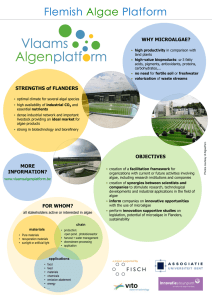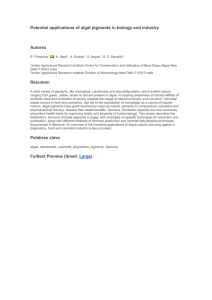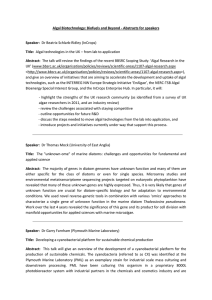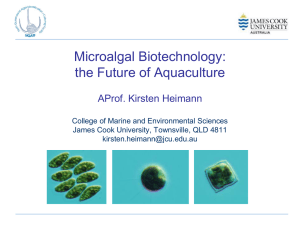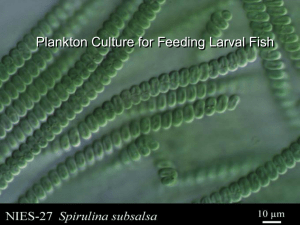3 Algae_Culture_Cursus_Lecture3
advertisement
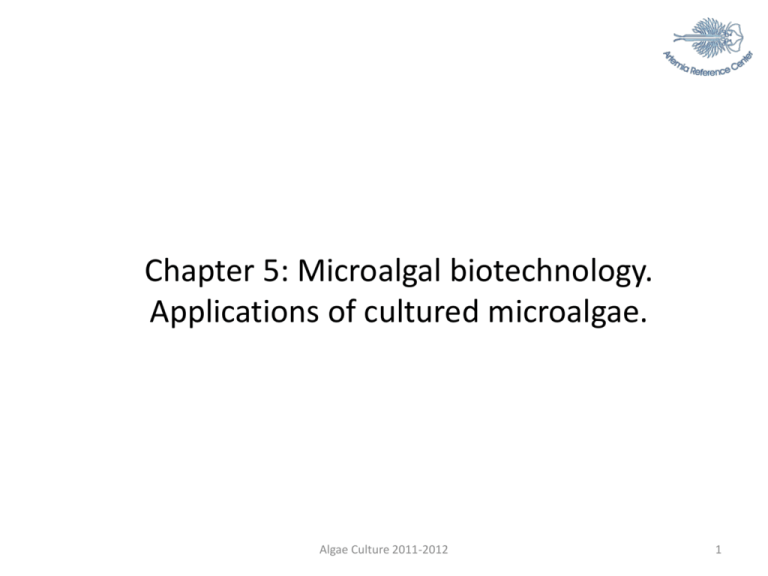
Chapter 5: Microalgal biotechnology. Applications of cultured microalgae. Algae Culture 2011-2012 1 Algal biomass Algae Culture 2011-2012 2 Health food and nutraceuticals Nutraceutical, a term combining the words “nutrition” and “pharmaceutical”, is a food or food product that provides health and medical benefits, including the prevention and treatment of disease. The term health food is generally used to describe foods that are considered to be beneficial to health. Of the numerous attempts to explain the healthpromoting effects of microalgal biomass, a general immune-modulating effect is most likely responsible. Studies show that Spirulina has a positive effect on human intestinal microflora. Algae Culture 2011-2012 3 Animal feed There is evidence that very small amounts of microalgal biomass, almost exclusively of the genra Chlorella, Scenedesmus and Spirulina, can positively affect the physiology of animals. In particular, a non-specific immune response and a boosting of the immune system of the animals was observed. Another very promising application for microalgal biomass or even extracts is the pet food market, where not only the health-promoting effects but also effects on the external appearance of the pet are of consumer’s importance. Algae Culture 2011-2012 4 Aquaculture At the basis of the natural food chain, microalgae play a key role in aquaculture, especially in mariculture, being the food source for larvae of many species of mollusks, crustaceans and fish. In addition, microalgae serve as a food source for zooplankton production (rotifers, copepods), which in turn are used as feed for rearing fish larvae. Algae Culture 2011-2012 5 Aquaculture The addition of astaxanthin-containing microalgae to feed formulations enhances the color of the muscles of salmonids. Culture techniques for Haematococcus plucialis are well developed for this purpose. Furthermore, the color-enhancing effects of phycocyanin-containing Spirulina biomass or carotenoids from Dunaliella were exploited in ornamental fish. Algae Culture 2011-2012 6 Valuable substances from microalgae Algae Culture 2011-2012 7 Polyunsaturated fatty acids Humans and animals are not able to synthesize PUFA. Besides being a primary source of PUFA, these fatty acids from microalgae have further advantages over fish oils, such as the lack of unpleasant odor, reduced risk of chemical contamination (toxin bioaccumulation by fish) and better purification potentials. Algae Culture 2011-2012 8 Chemical structure or EPA and DHA Heterotrophic production of EPA/DHA EPA production among algae EPA production under various conditions PUFA content Algae Culture 2011-2012 13 Antioxidants Due to their phototrophic life, microalgae are exposed to high oxygen and radical stress. This has resulted in the development of numerous efficient protective systems against oxidative and radical stressors. Algae Culture 2011-2012 14 Coloring products Microalgae contain a multitude of pigments which are associated with light incidence. The pigments improve the efficiency of light energy utilization (phycobiliproteins) and protect them against solar radiation (carotenoids). – β-Carotene from Dunaliella in health food as a vitamin A precursor – Astaxanthin from Haematococcus in aquaculture for coloring muscles in fish – Lutein, zeaxantin and canthaxantin for chicken skin coloration, or for pharmaceutical purposes – Phycobilliproteins for food and cosmetics coloration, and medical applications Algae Culture 2011-2012 15 Algal pigments Algae Culture 2011-2012 16 Algal pigments Algae Culture 2011-2012 17
